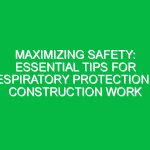In the bustling world of construction, where the sound of machinery and the sight of towering structures dominate, lies an underlying principle that ensures the heartbeat of progress continues safely: Hazard Communication. This cornerstone of Health Safety and Environment (HSE) practices is not just about compliance; it’s about creating a culture of safety that protects every worker on site. In this comprehensive guide, we’ll dive into the essentials of mastering hazard communication on construction sites, ensuring that safety is not just a priority but a way of life.
The Foundation of Hazard Communication
Before we delve into the specifics, it’s crucial to understand what hazard communication, often abbreviated as HazCom, entails. At its core, HazCom is about the right to know. It’s a framework designed to ensure that information about the chemicals and hazards present on a construction site is readily available and understandable to all workers, empowering them to protect themselves and their colleagues.
Why is Hazard Communication Critical?
The construction industry is inherently risky, with various hazards lurking around every corner. From toxic chemicals to explosive materials, the range of potential dangers can be daunting. Effective hazard communication acts as a beacon, guiding workers through the fog of risks, ensuring they are informed, prepared, and protected.
Key Components of an Effective Hazard Communication Program
An effective HazCom program is not a one-size-fits-all solution but rather a tailored approach that addresses the specific needs and risks of a construction site. However, certain universal elements form the backbone of any successful program.
Comprehensive Hazard Inventory
The first step in mastering hazard communication is to conduct a thorough inventory of all hazardous materials on site. This inventory serves as the foundation for all subsequent HazCom activities, from training to emergency response planning.
Material Safety Data Sheets (MSDS) and Safety Data Sheets (SDS)
MSDS and SDS are critical components of HazCom, providing detailed information about the properties, hazards, and safe handling practices for each hazardous material. Ensuring that these documents are accessible and understandable is paramount for worker safety.
Effective Training Programs
Knowledge is power, especially when it comes to hazard communication. Tailored training programs that address the specific hazards and safety protocols of a construction site are essential. These programs should be interactive, engaging, and ongoing to keep safety at the forefront of every worker’s mind.
Clear Labeling and Signage
Clear, concise, and consistent labeling and signage are vital for hazard communication. They serve as immediate visual cues, alerting workers to potential dangers and guiding them towards safe practices.
Challenges in Implementing Hazard Communication
While the benefits of an effective HazCom program are clear, several challenges can impede its implementation. These include language barriers, literacy levels, and the transient nature of construction workforces. Overcoming these obstacles requires creativity, commitment, and collaboration.
Overcoming Language and Literacy Barriers
Construction sites often host a diverse workforce, with workers speaking different languages and possessing varying levels of literacy. Tailoring HazCom materials and training to accommodate these differences is crucial for ensuring that every worker understands the hazards and safety protocols.
Adapting to a Transient Workforce
The ever-changing composition of construction workforces, with workers frequently moving between sites, poses a challenge to maintaining consistent hazard communication. Implementing standardized HazCom practices across sites can help mitigate this issue.
Technological Advances in Hazard Communication
The digital age has brought about innovative tools and technologies that enhance hazard communication on construction sites. From mobile apps that provide instant access to SDS to wearable devices that alert workers to hazards in real-time, technology is revolutionizing how we approach safety.
Leveraging Mobile Apps for Instant Access to Information
Mobile apps offer a convenient and efficient way for workers to access HazCom information, such as SDS, directly from their smartphones. This instant access can be a game-changer in emergency situations.
Wearable Safety Devices
Wearable devices equipped with sensors can detect hazardous conditions, such as toxic gas levels or extreme temperatures, and alert workers in real-time. These devices represent the cutting edge of hazard communication technology.
Creating a Culture of Safety Through Effective Hazard Communication
Ultimately, the goal of mastering hazard communication is to foster a culture of safety where every worker is empowered to take responsibility for their safety and the safety of their colleagues. This culture is built on trust, transparency, and teamwork, with effective HazCom practices at its core.
Empowering Workers with Knowledge and Tools
Empowering workers with the knowledge and tools they need to navigate the hazards of a construction site safely is the essence of hazard communication. When workers feel informed and equipped, they are more likely to engage in safe practices and advocate for a safer work environment.
Fostering Open Communication and Collaboration
Open communication and collaboration among all stakeholders on a construction site are vital for identifying and mitigating hazards. Encouraging workers to share their insights and concerns can lead to innovative solutions and a stronger safety culture.
Summary of Key Points
Mastering hazard communication on construction sites is not just about compliance; it’s about building a foundation of safety that protects every worker. By understanding the critical components of an effective HazCom program, overcoming implementation challenges, leveraging technology, and fostering a culture of safety, we can unlock the door to a safer construction industry. Remember, when it comes to safety, we’re all in this together.


